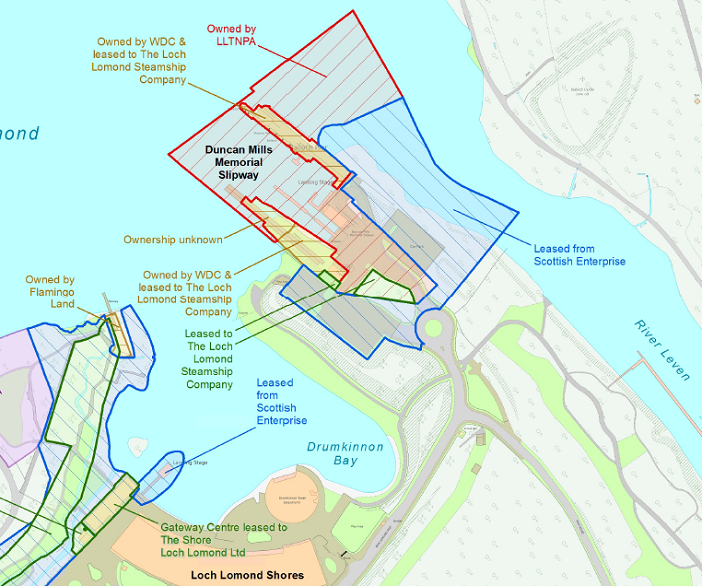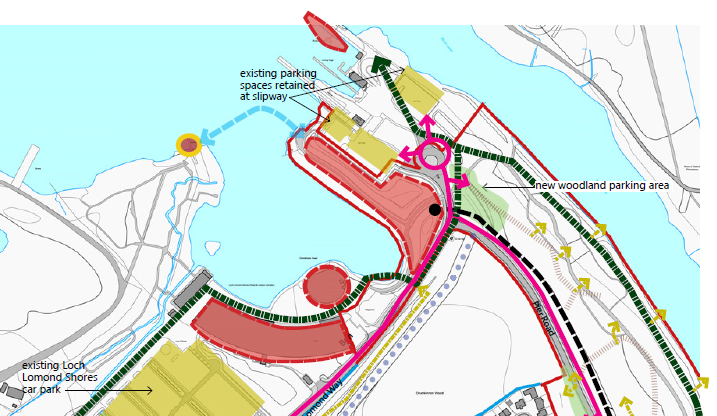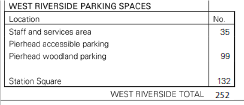
Hidden away among the many comments on Flamingo Land’s Planning Application is a letter from Emma Yendell, Estates Manager with the Loch Lomond and Trossachs National Park Authority (LLTNPA) (see here). While comments from other Public Authorities are mostly highlighted as such, this one from the LLTNPA is marked as “correspondence” and easy enough to miss. That is a shame because it is well considered and raises a number of serious concerns about the potential impact of the proposed development on the pierhead area and the Duncan Mills slipway, the only public access point for boat users to Loch Lomond.
Landownership and management at the pierhead is complex (see map above) but one of the few significant differences between Flamingo Land’s 2019 application and the current one (see here) is that the land owned and leased by the LLTNPA there is now excluded from the planning application. Moreover, having failed to comment publicly on the potential impact of the Flamingo Land development on the land they own in 2019, the LLTNPA has now done so. This change in approach by the LLTNPA is very significant and I consider the reason for that below.
The LLTNPA’s response to Flamingo Land Mark II
The LLTNPA’s response starts by outlining some of the history of the site. It explains that the area the LLTNPA now owns was transferred to its predecessor, the Lomond Park Authority, on condition:
“it would develop the land to include, among other things, a public boat launching slipway, facilities building, car and trailer parking and related infrastructure and car parking”.
This was tied in with European Regional Develop Fund money which was used to finance the development. The letter goes on to describe the current role of the slipway and the heavy use it receives. It appears clearly motivated by a concern to protect boat users and their ability to enjoy the loch.
The response then identifies a number of serious concerns about the potential impact of Flamingo Land’s proposed development on the operation of the pierhead area. These include:
- the map (see below) shows the planning application boundary cutting through a number of parking spaces used to park boats on trailers, potentially making them unusable:
- the proposed monorail to the visitor attraction could, if not high enough, prevent some boats (with masts) and boatlifting equipment (cranes) from accessing the site by the road beneath;
- increased visitors to the pierhead arriving by care will inevitably result in more congestion and this will impact on the ability of people to launch boats onto the loch;
- the situation could be made worse if even some of the people booking lodges on the land to the south bring boats and need to store them overnight (ie before launching);
- the proposals to use part of the car parking area as a works compound during the construction of the hotel and visitor attraction will inevitably impact on the ability of the public to launch boats.
A graphic illustration of the issues is provided by the map in Flamingo Land’s design statement on Parking and Movement:

The pink lines on the map show how traffic will flow in through a constricted entrance into what is a fairly restricted area with limited capacity. The issue is if dozens of people try to access the proposed hotel and new visitor attraction (the area in red) by car, they will do so on land owned and leased by the LLTNPA and used for other purposes. One senses the LLTNPA is rightly concerned it will be left to pick up the pieces. So why, one might ask, did they not raise the issues first time round?
The LLTNPA’s letter is doubly important because the response submitted on behalf of Loch Lomond Association (see here), at one time a powerful force advocating for the rights of boat users, while expressing concern about the increase in traffic in Balloch generally says nothing about the likely consequences at the pierhead.
Unfortunately, having identified a major problem with the proposed development, the letter:
“asks for conditions to be placed on any planning permission granted to ensure that the development does not cause detriment to the existing uses of the land and property occupied and managed by the Park Authority, or any other third parties associated with this existing use as described above”.
This is a cop-out. The questions that need to be answered are can the issues be addressed, if so how and what are the implications of this? For example, is it feasible to build the monorail high enough to allow cranes, if needed, to continue to access the site and what would the landscape implications be?
What Flamingo Land’s application says about traffic at the pierhead
Section 6.4 of Flamingo Land’s Design Statement on “Movement and Parking” starts with what appears to be a promising claim:
“Traffic will be controlled and excluded from most areas, and the public will continue to be able to walk through virtually all areas of the site”.
But it quickly becomes apparent that whatever controls are put in place – and these have not been specified – will not apply to the Pierhead area:
“Some traffic will be allowed into the site (for example slipway and Pierhead users, people with a disability)”.
And it is clear that pierhead users include not just people who use the current facilities but people who will be attracted to the new hotel and visitor attraction, hence the proposal to create a new 99 place car park in woodland in what is currently a public park:
 This shows that Flamingo Land’s claim that “most visitors will need to park their car in one of the designated parking spaces and travel either on foot, by bicycle or on a monorail which starts at the Station Square and ends at the Pierhead Visitors Hub” is totally misleading. Most will be able to park on site.
This shows that Flamingo Land’s claim that “most visitors will need to park their car in one of the designated parking spaces and travel either on foot, by bicycle or on a monorail which starts at the Station Square and ends at the Pierhead Visitors Hub” is totally misleading. Most will be able to park on site.
Flamingo Land go on to state that “Traffic access [to the pierhead] will be predominantly along Ben Lomond Way which will be retained as an adopted road. Vehicle access will be controlled along Pier Road, which is currently unadopted………………………….”. What this means is that anyone who wants to get to the visitor attraction will be able to drive by car along Ben Lomond Way at the end of which they will be funnelled into the pierhead area managed by the LLTNPA. What happens when the capacity of the new woodland parking is full is not explained but should be obvious: chaos! This will affect not just people going to the visitor attraction but those wanting to launch boats or people with disabilities, say, wanting to visit the Maid of the Loch.
The LLTNPA’s conflict of interest in the Flamingo Land planning application
Usually, where a proposed development had serious implications for the public and the owner was a public authority, one would expect the public authority to submit a provisional objection to the planning application. This could then be withdrawn if the issues they have identified are satisfactorily resolved. It is significant the LLTNPA have not done so in this case.
What is more, even though the LLTNPA has commented on the implications for the land they own at the pierhead, they have not made a single comment – positive or negative – about the other land and buildings they lease around Drumkinnon Bay, including the former National Park Gateway Centre. This is very strange. For example, the hundreds of visitors attracted to the development might help make turn the former Gateway Centre into a viable business proposition but at the same time affect the amenity value of the land the LLTNPA manages through increased litter. How does this balance out and will the development create more costs for the public purse
The limitations of the response from LLTNPA staff can be explained by the fact that their senior management have been behind the Flamingo Land development from the start, regardless of the consequences for local people and visitors to the National Park, and that conflict of interest has never been resolved. Having previously revealed the LLTNPA’s involvement in the appointment of Flamingo Land as preferred developer for the Riverside Site (see here), in December 2019 (see here) I explained the extensive conflicts of interests behind the previous application and that these still require to be investigated. They never have been.
All these conflicts of interest would have exposed the LLTNPA to legal challenge had they approved Flamingo Land’s Planning Application in 2019. Hence, I believe, why much of the Pierhead Area has been excluded from the current application and hence why LLTNPA staff have been allowed to comment on it. LLTNPA senior managers wish to appear to have followed due process.
But in ticking those boxes, senior management also don’t want staff to do anything that might actually prevent the development from being approved. Hence why the LLTNPA in its capacity as landowner and land-manager has handed over the issues they have identified at the pierhead to planning staff to address rather than lodging an objection.
I further explored these conflicts of interest in 2021 (see here) after Gordon Watson, the LLTNPA’s Chief Executive, falsely claimed in public that the decision to appoint Flamingo Land “was made by Scottish Enterprise alone”. No it wasn’t, the LLTNPA were on the interview panel. The Convener, James Stuart, then refused to get a Board Member to investigate this. This strongly suggests that the conflicts of interest remain. The good thing is that because of this the LLTNPA Board is likely to be open to legal challenge if they ever do approve the current application.
What needs to happen
As far as I am aware, most of the concerns raised by LLTNPA staff about the potential impact of Flamingo Land’s proposed development on the pierhead area have not so far been lodged as formal objections. It would help if the interested public now did so. People could also lodge comments on the implications for the other land that the LLTNPA manages around Drumkinnon Bay, while calling LLTNPA staff to be allowed to comment on those openly too.
The potential impact of the proposed development on the pierhead area showss that the LLTNPA should require Flamingo Land to produce clear and detailed proposals for parking and traffic management across the site as a whole BEFORE any “Planning Permission in Principle” is considered. At present Flamingo Land is trying to delay consideration of this to future planning applications which will cover specific parts of the site. But the potential for traffic chaos and the climate emergency mean that the LLTNPA should be considering these issues up front and requiring Flamingo Land to come up with satisfactory solutions – e.g a car free “resort” – as part of their application for Planning Permission in Principle.

Agreed. “Cop out” is right. “Conditions” are a way to grease the wheels for approval. They’re not enforced and won’t see the light of day after the fact….except on paper. Conflicts of interest abound to such and extent we are in the realms of fantasy theatre planning. These people should have been taken to Court a long time ago. The locals have been preoccupied coping with the fallout from the bank crash, austerity and “Forever War.” When the cat’s away the mice will play and for those with £40 million to spare it’s never let a good crisis go to waste. So, the stage is all set to make a killing. But I have already proved the NP is seriously conflicted…..in the Decision Notice of the Scottish Information Commissioner, 081/2011, Ref: 201100110, Date: 21 April. Part 11 the Commissioner could not comment on whether the information the NP used in support of the application for pontoon moorings on the R Leven was appropriate or fit for purpose. But there never was any objective, proactive scientific research done to find out what the material impact was on the natural fish habitat and fish populations of all of those boats and moorings crammed into that space between the Gates and the Loch. It was all desktop rip-offs from the internet. These NP people take the public for fools who don’t know the difference between a “philosophy lesson” and getting off your butt and doing a proper days work outdoors and hands on. It’s been like that all along….looking for the material evidence basis for what they’re saying and finding none. They’re running a soap opera.